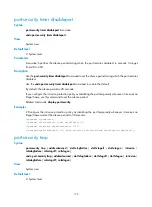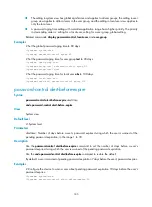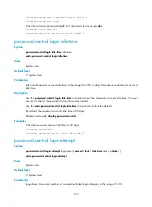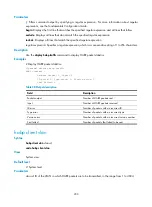
185
•
The setting in system view has global significance and applies to all user groups, the setting in user
group view applies to all local users in the user group, and the setting in local user view applies to
only the local user.
•
A password aging time setting with a smaller application range has a higher priority. The priority
in descending order is: setting for a local user, setting for a user group, global setting.
Related commands:
display password-control
,
local-user
, and
user-group
.
Examples
# Set the global password aging time to 80 days.
<Sysname> system-view
[Sysname] password-control aging 80
# Set the password aging time for user group
test
to 90 days.
[Sysname] user-group test
[Sysname-ugroup-test] password-control aging 90
[Sysname-ugroup-test] quit
# Set the password aging time for local user
abc
to 100 days.
[Sysname] local-user abc
[Sysname-luser-abc] password-control aging 100
password-control alert-before-expire
Syntax
password-control alert-before-expire
alert-time
undo password-control alert-before-expire
View
System view
Default level
2: System level
Parameters
alert-time
: Number of days before a user's password expires during which the user is warned of the
pending password expiration, in the range 1 to 30.
Description
Use the
password-control alert-before-expire
command to set the number of days before a user's
password expires during which the user is warned of the pending password expiration.
Use the
undo password-control alert-before-expire
command to restore the default.
By default, a user is warned of pending password expiration 7 days before the user's password expires.
Examples
# Configure the device to warn a user about pending password expiration 10 days before the user's
password expires.
<Sysname> system-view
[Sysname] password-control alert-before-expire 10






























